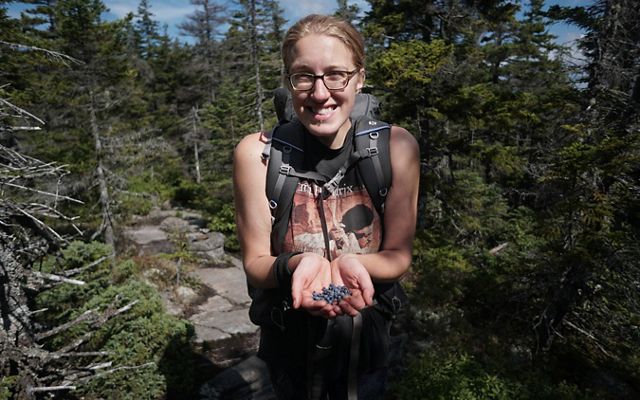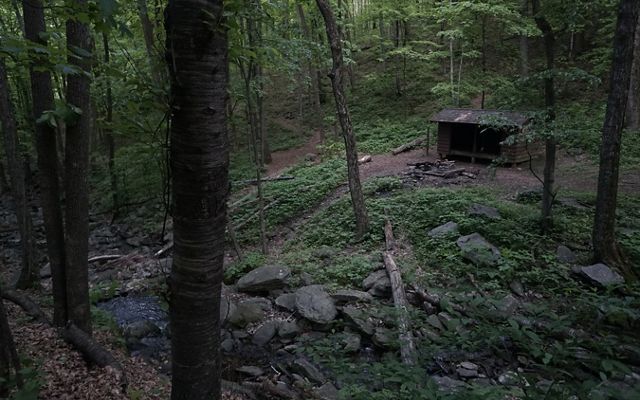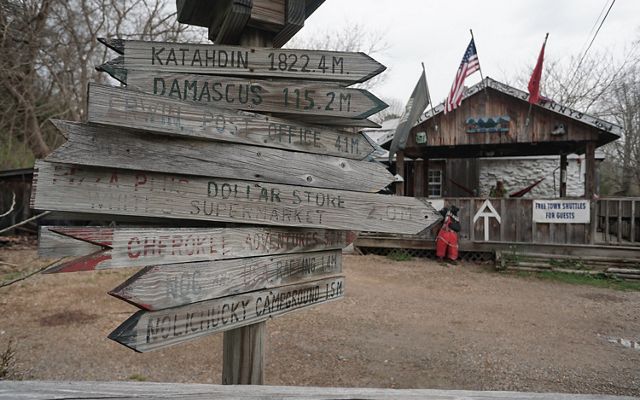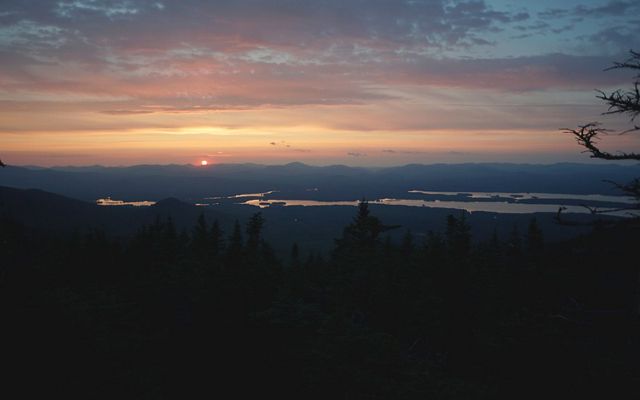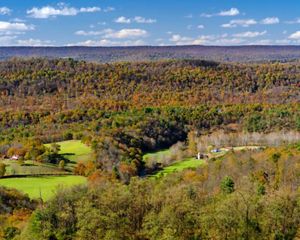
Connecting With Nature on the Appalachian Trail
The Appalachian Trail is a true spectacle of nature’s beauty. MD/DC's Sarah Hamang was up for the challenge—and conquered it!
Spanning 2,192 miles across 14 states on the East Coast, the Appalachian Trail (AT) is a true spectacle of nature’s beauty, available to any hiker who is up for the challenge. Sarah Hamang, the Maryland/DC chapter’s philanthropy operations manager, was not only up for the challenge—she conquered it!
Sarah spends her work hours crunching numbers, editing spreadsheets and checking email. There are not many opportunities for her to enjoy nature on the weekdays, but in her spare time, Sarah thoroughly enjoys participating in outdoor activities such as hiking and camping, especially with her longtime partner Jacob Fisk. Given her passion for the environment and for conservation, hiking the AT was a bucket list item for Sarah. On June 18, 2018, that dream started to become a reality.
A lot has changed since Sarah completed her hike and sat down for this interview. She shares some recent reflections:
This spring, as the world shut down, I, like many others found solace and peace in spending time outdoors. I now have a better understanding and newfound appreciation of my neighborhood. Before COVID-19, I honestly can’t remember the last time I just took an hour-long walk around the block! Of course, I’m always wearing a mask when I’m outside in DC.
Jacob and I also celebrated the anniversary of our journey this summer. It’s been a real boon to look at the photos from our hike and remember all of the times on the Trail when we met new friends and could gather together without concern.
I know that there will be a time when we can gather again and share close quarters in the outdoors with others. Until then, I can share that COVID-19 has made me even more grateful for the adventure I was able to enjoy just a short time ago. And, the time inside has given me plenty of opportunities to plan for my next outdoor adventure.
Quote: Sarah Hamang

I know that there will be a time when we can gather again. Until then, I can share that COVID-19 has made me even more grateful for the adventure I was able to enjoy just a short time ago.
Being a strategic duo, Sarah and Jacob decided to hike the AT in two parts. From June to September 2018, Sarah and Jacob planned to hike the northern portion of the Trail, from Harpers Ferry, WV to Mount Katahdin, Maine. Then, from March to May 2019, the two would resume their journey by hiking the southern portion of the trail, starting at Springer Mountain in Georgia and concluding where they started: Harpers Ferry, WV. The plan seemed plausible on paper, and despite weather challenges as well as physical and mental obstacles, the two achieved their goal while creating memories that will last a lifetime.
The Nature Conservancy: How long had you toyed with the idea of hiking the AT? And why is it considered such a challenge to hike?
Sarah Hamang: I’ve thought about hiking the AT for about six or seven years and my goal was to hike it before I turned 30. I celebrated my 30th birthday in February 2020, so I made the goal with about eight months to spare. It is challenging because there are 464,500 feet in elevation gained and lost on the Trail, making it the equivalent of climbing up and down Mount Everest 16 times!
Congratulations on achieving your goal! Your photos are truly inspiring; were you and Jacob admiring breathtaking views the whole time?
I’d like you to think that we saw these beautiful sweeping views all the time while on the trail; however, 95 percent of the time, you are just looking at your feet. It’s safer that way.
In fact, we went through five different pairs of shoes. Trail runners are really light and breathable, which makes them good for hiking the trail, but they only last about 400 to 500 miles. So, every six to seven weeks, we’d go through another pair of shoes. To get a new pair, we would order them online and have them shipped to the nearest post office, which I realize is not always a luxury AT hikers have had.
Given your role at TNC in Maryland/DC, what are your thoughts on how conservation in Maryland impacts the AT?
The Appalachian Trail Conservancy, The Nature Conservancy and other conservation groups all play a key role in keeping that narrow-forested corridor in western Maryland natural and protected. This is important not just for AT hikers who enjoy the view, but for all species that we know will be shifting their ranges north as the climate warms.
By expanding our scientific understanding of forest resiliency and by communicating best forest maintenance practices with private landowners, TNC in western Maryland is ensuring habitat and safety for nature’s travelers.
Where would you and Jacob sleep while on the trail? And what would you two eat? I understand that hikers should eat approximately 5,000 calories a day to maintain themselves.
We usually slept in shelters along the trail because it’s a lot easier than setting up a tent every night and having to break it down in the morning. And every week or so, we would treat ourselves to a hotel room to spend the night in a real bed, do laundry, stock up on food and eat a huge dinner.
We ate out of a package almost exclusively the entire time we were on the trail. A popular meal was instant mashed potatoes with ramen noodles in them, it’s called a ramen bomb—very calorically dense, very starchy.
I’ve heard that everyone who hikes the AT receives a trail name. What names were given to you and Jacob?
I was given my name in New York. It was really hot and there was a group of weekend hikers who didn’t bring any water. So they hiked down the mountain to get some, came all the way back up, and then starting boiling the water to filter it. They were trying to give water to this one overheated guy who had just hiked down and back. I happened to have some extra water with me that I put electrolytes in. I gave it to him, and he started to calm down. That’s how I got my trail name, Electrolyte.
Jacob’s story is a little less graceful. One night, he spilled noodles everywhere on the ground, but that was all the food we had to eat for dinner. So, he got down and was ‘harvesting’ them. Hence, Jacob became Noodle Harvester.
Are there other traditions associated with the AT that people might not know?
There are a lot of challenges on the AT. People try to entertain themselves by doing all sorts of things because walking can be pretty boring. For example, there’s a fun tradition at Pine Grove Furnace in Pennsylvania (about halfway through the AT if you start in Georgia)—a challenge to eat a half gallon of ice cream in 30 minutes or less. I know the gentleman who holds the fastest record from last year. He ate the half gallon of ice cream in 12 minutes, and apparently had cold burns in his throat weeks after.
There’s another challenge called the four-state challenge where you start in Virginia and hike to Pennsylvania in 24 hours or less, that’s 42 miles.
My favorite, which I did not do but thought about, is the West Virginia challenge, where you listen to John Denver’s “Take Me Home, Country Roads” the entire time you hike through West Virginia. It’s about 6 miles, but that’s around 3 hours of listening to that song.
What surprised you the most while on your hike?
Two things really stuck with me. For one, many people use the trail as their place to access and experience nature. We interacted with a lot of day hikers from all walks of life, who often hailed from urban areas. The Trail really connects people with nature.
Secondly, you have so much time to think—to process things that have happened to you, think big picture thoughts that you don’t really allow yourself to think in ‘normal’ life. It can be very philosophical.
I can only imagine how exhausting it is to hike the AT. How did you take breaks and relax along the way?
What would really refresh me was just kind of taking a day off to enjoy my surroundings. It was so funny; all of us on the AT, when we were sitting around, everyone still wanted to be outside, which was really interesting. It was almost like taking a break from nature but still needing nature to revive or rejuvenate you.
I would take a book and go sit outside and read. Even though I wasn’t hiking, I still wanted to be outside. And I think what kept me going in those times that I felt like, “I can’t do this anymore I want quit”, was that gratitude that I could take the time to be out in nature and restore my sense of peace and calm.
With all that time outside, I am sure you saw all kinds of wildlife.
I’d never seen a bear in the wild and I saw nine in Virginia, mostly in Shenandoah. I also heard a beaver chomping wood for the first time, which is a crazy loud sound. Those are some of the most memorable observations.
Did you and Jacob ever consider quitting?
There were a lot of times that we thought about it, but we never really seriously thought about it. We sublet our apartment, so we literally had nowhere to come back to. This was the time in our lives we had budgeted to do this, so when else would we do it if not now?
Now that you have actually completed your goal of hiking the AT, how do you feel?
It’s definitely the hardest thing I’ve ever done in my life, but the reward that you feel for having accomplished something that you didn’t think you could do is really amazing. Now I feel like I could do anything after hiking the Appalachian Trail.
Do you have any advice for someone who may be considering hiking the AT?
It’s a really big commitment. I don’t think you should ever do it because someone else wants to do it. It has to be a very personal decision. Give your body time to adjust to the strain and enjoy it as much as you can, because you will probably never get a chance in your lifetime to do something like that again.

How was it coming back to “normal” life after finishing the hike?
I remember coming back to DC after being gone last summer and waiting at a bus stop for a bus that was coming in a minute or two and being so surprised by the fact that no one seemed able to just stand and be at the bus stop. Everyone was on their phone.
Do you have any final thoughts about your experience?
While on the Trail, I remember being very humbled and grateful that nature exists in the way that it does and will continue to exist despite all of the pressures that we’re putting on our planet. So, thanks to all of you that work to protect it by volunteering outside and supporting environmental conservation with your time, talent and treasure.
Stay in Touch
Subscribe to Nature News, our monthly e-newsletter. Get the latest news and updates about our conservation efforts both here in Maryland and DC and around the world, delivered straight to your inbox.



